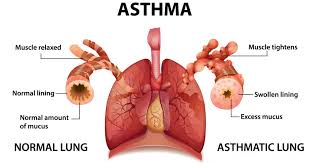Asthma: A Comprehensive Overview 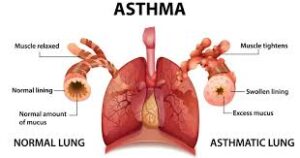
Asthma is a chronic respiratory condition characterized by inflammation and narrowing of the airways, which can lead to difficulty breathing. It affects millions of people worldwide, impacting their quality of life and posing significant public health challenges. This overview explores the nature of asthma, its causes, symptoms, diagnosis, treatment, and strategies for management and prevention.
Understanding Asthma
Asthma is classified as a chronic inflammatory disease of the airways. The inflammation leads to increased responsiveness of the airways to various stimuli, causing recurrent episodes of wheezing, breathlessness, chest tightness, and coughing. These symptoms can vary in frequency and intensity, often worsening at night or in the early morning.
Types of Asthma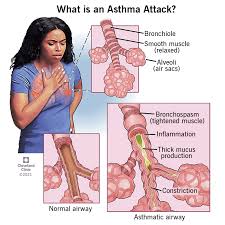
Asthma can be categorized into several types based on different criteria:
- Allergic (Extrinsic) Asthma: Triggered by allergens such as pollen, dust mites, mold, and pet dander. This type is often associated with other allergic conditions like hay fever and eczema.
- Non-Allergic (Intrinsic) Asthma: Triggered by factors other than allergens, such as stress, respiratory infections, cold air, exercise, or exposure to irritants like smoke and strong odors.
- Exercise-Induced Asthma: Symptoms triggered by physical activity, particularly in cold or dry air.
- Occupational Asthma: Caused by exposure to allergens or irritants in the workplace, such as chemicals, dust, or fumes.
- Cough-Variant Asthma: Characterized primarily by a persistent cough, without significant wheezing or shortness of breath.
Causes and Risk Factors
The exact cause of asthma is not fully understood, but it is believed to result from a combination of genetic and environmental factors:
Genetic Factors
- Family History: Individuals with a family history of asthma or other allergic conditions are more likely to develop asthma.
- Genetic Predisposition: Certain genes associated with immune function and airway inflammation may increase susceptibility to asthma.
Environmental Factors
- Allergens: Exposure to allergens such as pollen, dust mites, mold, pet dander, and cockroach droppings can trigger asthma symptoms.
- Air Pollution: Exposure to environmental pollutants, including tobacco smoke, vehicle emissions, and industrial chemicals, is linked to asthma development and exacerbation.
- Respiratory Infections: Viral respiratory infections, particularly in early childhood, can increase the risk of developing asthma.
- Weather Conditions: Changes in weather, such as cold air or high humidity, can trigger asthma symptoms.
Lifestyle Factors
- Obesity: Being overweight or obese increases the risk of developing asthma and can worsen existing asthma symptoms.
- Physical Inactivity: Lack of physical activity may contribute to the severity of asthma symptoms.
Symptoms of Asthma
Asthma symptoms can vary widely among individuals and may include:
- Wheezing: A high-pitched whistling sound when exhaling, often associated with airway narrowing.
- Shortness of Breath: Difficulty breathing, particularly during physical activity or at night.
- Chest Tightness: A feeling of pressure or constriction in the chest.
- Coughing: Frequent coughing, especially at night or early morning, which may worsen during respiratory infections.
Diagnosis
Diagnosing asthma typically involves a combination of medical history, physical examination, and diagnostic tests:
- Medical History: The healthcare provider will ask about the patient’s symptoms, their frequency and severity, potential triggers, and family history of asthma or allergies.
- Physical Examination: A thorough examination may include listening to the lungs for wheezing or other abnormal sounds.
- Pulmonary Function Tests (PFTs): These tests measure lung function and capacity. The most common test is spirometry, which assesses how much air the patient can exhale and how quickly.
- Peak Flow Measurement: This involves using a peak flow meter to measure how fast air can be exhaled, providing insight into airway obstruction.
- Allergy Testing: Skin or blood tests may be conducted to identify specific allergens that may trigger asthma symptoms.
- Bronchodilator Reversibility Testing: After administering a bronchodilator, a follow-up spirometry test can determine if asthma is present based on improvement in lung function.
Treatment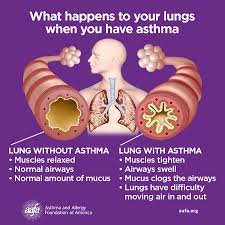
Asthma treatment aims to control symptoms, reduce inflammation, and prevent asthma attacks. Management strategies include:
Long-Term Control Medications
These medications are taken daily to maintain control of asthma symptoms and prevent exacerbations:
- Inhaled Corticosteroids: These are the most effective long-term control medications, reducing inflammation in the airways (e.g., fluticasone, budesonide).
- Long-Acting Beta-Agonists (LABAs): These medications are often used in combination with inhaled corticosteroids to help keep airways open (e.g., salmeterol, formoterol).
- Leukotriene Modifiers: Oral medications that reduce inflammation and bronchoconstriction (e.g., montelukast).
- Theophylline: An oral medication that helps relax the airways, although it is used less frequently due to side effects.
Quick-Relief (Rescue) Medications
These medications provide rapid relief from acute asthma symptoms and are used during asthma attacks:
- Short-Acting Beta-Agonists (SABAs): These bronchodilators quickly relax airway muscles (e.g., albuterol, levalbuterol).
Biological Therapies
For individuals with severe asthma that does not respond to standard treatments, biologic therapies targeting specific pathways in the immune response may be considered:
- Omalizumab: A monoclonal antibody that targets IgE, reducing allergic reactions.
- Mepolizumab, Benralizumab, and Dupilumab: These target specific inflammatory pathways and are effective in certain patients.
Asthma Management Plan
A personalized asthma management plan is essential for effective control of the condition. This plan typically includes:
- Medication Instructions: Clear guidelines on when and how to use medications, including maintenance and rescue inhalers.
- Symptom Monitoring: Instructions on tracking symptoms and peak flow measurements to identify worsening asthma.
- Trigger Management: Strategies for avoiding known triggers, such as allergens, smoke, and respiratory infections.
- Emergency Plan: Instructions on what to do during an asthma attack, including when to seek medical help.
Lifestyle Modifications
Adopting certain lifestyle changes can help manage asthma more effectively:
- Avoiding Triggers: Identifying and minimizing exposure to allergens and irritants is crucial.
- Regular Exercise: Engaging in regular physical activity can improve lung function and overall health, although it’s important to manage exercise-induced symptoms.
- Healthy Diet: A balanced diet rich in fruits, vegetables, and omega-3 fatty acids may help reduce inflammation.
- Weight Management: Maintaining a healthy weight can alleviate asthma symptoms and improve overall health.
Complications of Asthma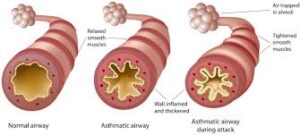
While asthma can often be managed effectively, complications may arise, particularly if the condition is poorly controlled:
- Frequent Asthma Attacks: Recurrent exacerbations can lead to increased healthcare visits and hospitalizations.
- Respiratory Failure: Severe asthma attacks may result in inadequate oxygen supply and require emergency intervention.
- Impact on Quality of Life: Chronic symptoms can limit daily activities and lead to psychological distress.
Asthma in Special Populations
Certain groups may experience asthma differently or face unique challenges:
- Children: Asthma is one of the most common chronic conditions in childhood. Symptoms may change as children grow, and some may outgrow their asthma.
- Elderly: Older adults may have more severe asthma due to age-related changes in lung function and comorbidities.
- Pregnant Women: Asthma can affect pregnancy outcomes, but with proper management, most women can have healthy pregnancies.
Public Health and Asthma
Asthma is a significant public health issue. Efforts to improve asthma management include:
- Awareness Campaigns: Educating the public about asthma symptoms, triggers, and management strategies can lead to early diagnosis and effective treatment.
- Access to Care: Ensuring that individuals have access to medications and healthcare providers is crucial for effective asthma management.
- Policy Initiatives: Implementing policies to reduce air pollution and improve indoor air quality can help lower asthma rates.
Conclusion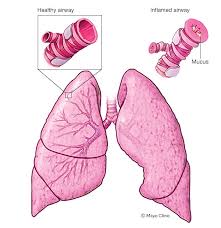
Asthma is a complex and prevalent respiratory condition that requires ongoing management and awareness. Understanding its causes, symptoms, and treatment options empowers individuals to take control of their health. With appropriate care and lifestyle modifications, most people with asthma can lead active, fulfilling lives. Continued research, public health initiatives, and patient education are essential in addressing the challenges posed by asthma and improving outcomes for those affected by this chronic disease.
